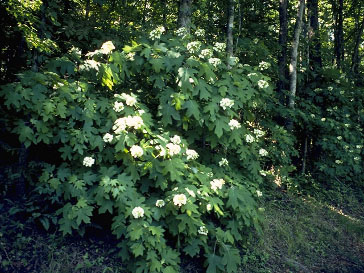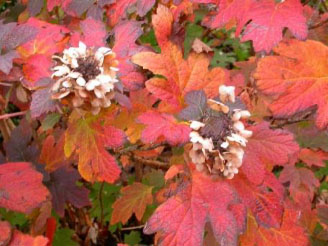Hydrangea quercifolia: Oakleaf hydrangea
 Latin name: Hydrangea quercifolia10
Latin name: Hydrangea quercifolia10
Common name: Oakleaf hydrangea10
Flowers: Progression from white-purple panicles in June and July persisting through midwinter10,13
Fruit or cones: Inconspicuous10
Height & Width: 6-8ft. tall and wide12
Type: Deciduous woody12
Habit: Multi-stemmed, upright, colonizing shrub10,12
Wetland indicator category**: Not found 2/11/202017
Texture: Course20
Growth rate: Fast19
Light: Part-shade to shade preferred10,12,13,19
Moisture: Medium-moist10,12,13
Soil*: Fertile, well-drained, 6.8-7.210,12,13,19
Zones: 5-912
Origin: Florida, Georgia, South Carolina, North Carolina, Tennessee, Alabama, Louisiana, Mississippi16
Ecosystem benefits: Low wildlife benefit, favorable to deer, attracts some butterflies and hummingbirds10,13,19
 Features: The Oakleaf Hydrangea is an easy to grow, mounding, shrub with beautiful panicles of creamy white flowers in the summer that dry to a dusty purple in early winter. An added interest of this specimen is the unique foliage which resembles large oak leaves and turns deep red-purple in the fall13,20.
Features: The Oakleaf Hydrangea is an easy to grow, mounding, shrub with beautiful panicles of creamy white flowers in the summer that dry to a dusty purple in early winter. An added interest of this specimen is the unique foliage which resembles large oak leaves and turns deep red-purple in the fall13,20.
Siting: Oakleaf Hydrangea makes an excellent accent for foundational planting as well as being right at home in woodland settings or shade gardens. This hydrangea is naturally found in moist, low lying areas and stream banks so prefers a well moistened soil and mulching especially in summer12,20.
Care: Plant so root flare is visible at soil surface14. At planting, water the root ball daily with two gallons of water per inch of trunk diameter for two weeks, every other day for two months and then weekly until established. Modify water recommendations to reflect site drainage and rainfall. Apply 3” of mulch over the planted area. Do not allow mulch to touch the trunk14. Apply follow up mulch in summer to retain a cool, moist environment12.
Pests: Plants are relatively pest resistant if cultural preferences are met. However, some susceptibility to leaf blight and powdery mildew has been observed and the occasional spider mite and aphid visitors12.
This plant does not appear on the following invasive plant lists on 2/11/2020:
USDA SC Invasive Plant Species
SC Exotic Plant Pest Council
Author: Tyler Lowery
Image source:
https://www.wildflower.org/gallery/result.php?id_image= 7838
https://www.missouribotanicalgarden. org/PlantFinder/FullImageDisplay.aspx ?documentid=7880
Sources:
- Armitage, A. (2001). Armitage’s manual of annuals, biennials, and half-hardy perennials. Portland, OR: Timber Press.
- Armitage, A. (2006). Armitage’s native plants for North American gardens. Portland, Oregon: Timber Press.
- Armitage, A. (2008). Herbaceous perennial plants: A treatise on their identification, culture, and garden attributes. Athens, GA: University of Georgia.
- Clemson Cooperative Extension Home and Garden Information Center.(2011). Flowers fact sheets. Retrieved from https://hgic.clemson.edu/category/flowers/
- Clemson Cooperative Extension Home and Garden Information Center.(2011). Groundcovers & vines fact sheets. Retrieved from https://hgic.clemson.edu/category/groundcovers/
- Clemson Cooperative Extension Home and Garden Information Center.(2011). Trees. Retrieved from https://hgic.clemson.edu/category/trees/
- Clemson Cooperative Extension Home and Garden Information Center.(2011). Shrubs. Retrieved from https://hgic.clemson.edu/category/shrubs/
- Dirr, M. A. (2009). Manual of woody landscape plants. Champaign, IL: Stipes Publishing.
- Gilman, E. F. (1997). Trees for urban and suburban landscapes. Albany, NY: Delmar Publishers.
- Lady Bird Johnson Wildflower Center University of Texas at Austin. (2012). Native plant information network. Retrieved from http://www.wildflower.org/explore/
- McMillan, P., Plant taxonomist Clemson University, personal communication.
- Missouri Botanical Garden Kemper Center for Home Gardening. Plant finder. Retrieved from http://www.mobot.org/gardeninghelp/plantfinder/Alpha.asp
- North Carolina State University (2005). Plant fact sheets. Retrieved from http://www.ces.ncsu.edu/depts/hort/consumer/factsheets/index.html
- Strother, E. V., Ham, D. L., Gilland, L. (2003) Urban tree species guide: Choosing the right tree for the right place. Columbia, SC: South Carolina Forestry Commission.
- University of Florida, IFAS Extension. (2011). Southern trees fact sheet. Retrieved from http://edis.ifas.ufl.edu/department_envhort-trees
- USDA . Plant profile. (n/d).Retrieved from http://plants.usda.gov/java/
- USDA. Plant wetland indicator status. (n/d). Retrieved from http://plants.usda.gov/wetland.html
- Vincent, E., Environmental horticulturist Clemson University, personal communication.
- Clemson Extension. Carolina Yards Plant Database. Retrieved from https://www.clemson.edu/extension/carolinayards/plant-database/index.htm
- Lowery, T., Clemson Horticulture student, personal experience
*Soil pH is determined using a professional soil test. Contact your Clemson University County Extension service for assistance www.clemson.edu/extension/. Click on “local offices”.
**2012 Plant Wetland Indicator categories (quantitative derived) http://plants.usda.gov/wetinfo.html
| Indicator Code | Indicator Status | Comment |
|---|---|---|
| OBL | Obligate Wetland | Almost always is a hydrophyte, rarely in uplands |
| FACW | Facultative Wetland | Usually is a hydrophyte but occasionally found in uplands |
| FAC | Facultative | Commonly occurs as either a hydrophyte or non-hydrophyte |
| FACU | Facultative Upland | Occasionally is a hydrophyte but usually occurs in uplands |
| UPL | Obligate Upland | Rarely is a hydrophyte, almost always in uplands |
